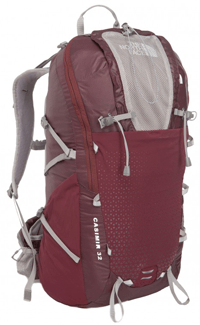Backpacks for Women – GearGuide
 In addition to the information in the GearGuide about backpacks, there are women-specific aspects that you can pay extra attention to when buying a backpack.
In addition to the information in the GearGuide about backpacks, there are women-specific aspects that you can pay extra attention to when buying a backpack.
Image: The North Face Casimir 32 liter women backpack
With regard to outdoor and action sports equipment, women now have more choice than ever before. What makes a backpack female-specific? Is it just a smaller backpack or is it the more vibrant colors? It is more than that: manufacturers have realized that there is a need for backpacks that take into account the female anatomy.
This section of the GearGuide describes a number of important aspects that are important when buying a “women-friendly” backpack. In addition, tips are given to make the choice easier.
Subjects:
- Saspectsaspecten
- How to choose
[/td_text_with_title]
Html code here! Replace this with any non empty text and that's it.
Specific aspects
Most women have narrower shoulders, shorter back lengths and wider hips than men. Women’s backpacks are designed with these aspects in mind, which translates into:
Slimmer forms
A narrower shape fits not only better, but will also contribute to a better fit and more comfort while hiking. The hips of women tend to move more while walking. A narrower, tapered backpack will prevent you from getting out of balance when walking over uneven terrain.
Shorter back panel and backpack length
The prefilled and preformed back panels in women’s backpacks are shorter because women generally have a shorter back length. A backpack that is too low on your back will be uncomfortable and will not be supported by your hips during walking.
Smaller frame
A shoulder armor with the shoulder straps placed closer to each other prevents them from slipping from your shoulders. The narrower shoulder straps can also be “sanded” along the forearms and “push” against the chest, which are common inconvenience when using the wide shoulder straps of a “men’s backpack.”
S-shape shoulder straps
Preformed shoulder straps provide a more comfortable fit around the chest. There are manufacturers who make shoulder straps that can rotate to allow the shoulder and neck angles to be adjusted (see illustration).
Conical shaped hip belt
The female hips have sharper angles than those of men and because the weight of the backpack rests on the hips, it is self-evident that the (fit) shape of the hip belt is crucial. Some women can wear a backpack for men, with the angle of the hip belt small (this is angled a bit inward). Other women know too well the feeling of a hip belt that presses into the bottom of the hips and does not rest on the top of the hips enough. A poorly fitting hip belt will lead to more weight on your (instead of on the hips), you will get tired faster.
Adjustable hip belt
There are currently backpacks on the market where the hip belt is adjustable, such as the angle at which the hip belt rests on your hips. This is a great benefit for women with larger hips because the hip belt can be adjusted to the hips.
Adjustable back panel
Of some large multi-day backpacks, it is possible to adjust the back panel to the upper body length, as women usually have a shorter upper body than men. There are backpacks on the market where the back panel is adjustable in steps per size. There are also manufacturers who offer the option to choose frame, armor and hip belt separately for optimal fit.
In conclusion
- Women-friendly backpacks are available in many types and sizes: from large backpacks for multi-day trips to small hydration packs.
- These backpacks have a shorter, narrower shape and curved shoulder straps that are tailored to the female body.
- Some backpacks have a replaceable “harness” and an adjustable hip belt with the angle adjustable for personal fit.
- Make sure you learn to pack your backpack well and put it on your back properly. This gives you more comfort at long distances.
